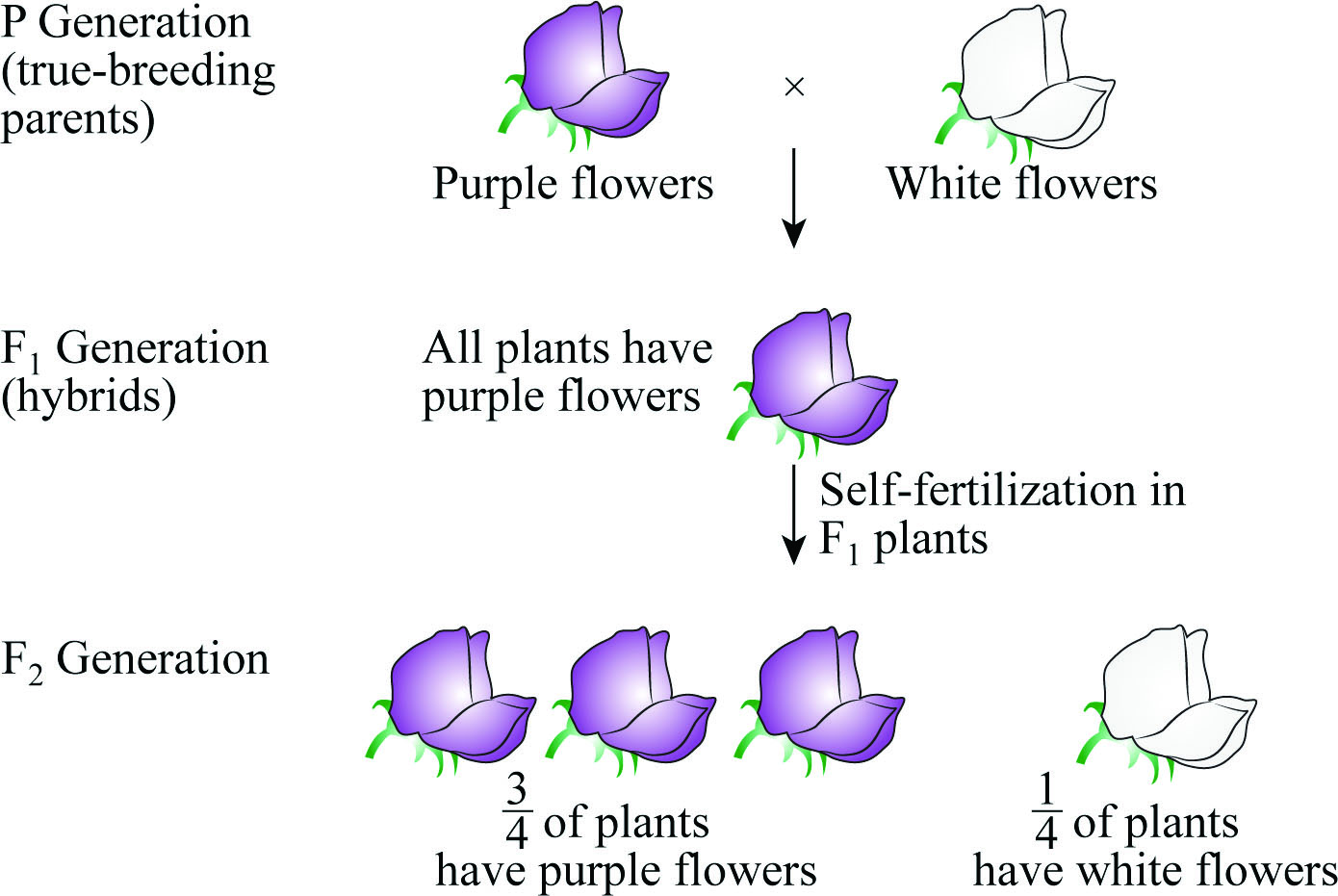
Concept explainers
When Mendel did crosses of true-breeding purple- and white-flowered pea plants, the white-flowered trait disappeared from the F1. generation but reappeared in the F2 generation. Use genetic terms to explain why that happened.
To explain: Why the white color trait disappeared in the F1 generation and was again observed in the F2 generation in Mendel’s cross between purple- and white- flowered pea plants.
Introduction: Genes have alternate forms known as alleles, which are transmitted to offspring. If the two alleles are different, then there is a hybrid in the F1 generation. The dominant allele out of the two expresses itself and determines the phenotype. In F1 individuals, two different alleles segregate into gametes. During self-pollination, the gametes unite randomly, thereby giving a chance to recessive alleles to be expressed in a homozygous state at the F2 generation.
Explanation of Solution
The cross between the individuals that are true breeding homozygous for one allele gives different traits in F1 progeny. This is called as monohybrid cross. Several traits of pea plants were studied in which Mendel used the purple- and white-colored flower traits to perform monohybrid experiment. When Mendel crossed these plants, the F1 hybrids or first true breeding generation received was both dominant and recessive alleles equally but showed a purple pigment. This is because the purple-colored trait was dominant over white. That is, white-colored trait is and was not expressed recessive in the F1 generation. However, the white trait was expressed in F2 generation of the experiment. This was because it is only possible for a white allele to exist in a homozygous state, which causes the white trait to be expressed in F2 generation.
Pictorial representation: Fig.1 shows Mendel’s cross between purple- and white-flowered pea plants.

Fig.1: Mendel’s cross between purple- and white-flowered pea plants
Want to see more full solutions like this?
Chapter 14 Solutions
CAMPBELL BIOLOGY,VOL.II >CUSTOM<
Additional Science Textbook Solutions
Chemistry: Structure and Properties (2nd Edition)
Human Biology: Concepts and Current Issues (8th Edition)
Genetic Analysis: An Integrated Approach (3rd Edition)
Organic Chemistry (8th Edition)
Microbiology: An Introduction
Anatomy & Physiology (6th Edition)
- 4.arrow_forward2arrow_forward1. 2. 3. Marine fish cells are hypotonic compared to their seawater environment; their cells lose water by osmosis and gain solutes. If you add heterotrophic respiration and autotrophic respiration together and then subtract that value from gross primary productivity, then you have a more refined estimate of ecosystem carbon storage than NEE. Differential heating due to the earth's tilt generates the global wind AND oceanic circulation patternsarrow_forward
- KD 200- 116- 66- Vec ATF6 (670) ATF6 (402) ATF6 (373) ATF6 (366) I I 45- 1 2 3 4 5 ATFG (360) (e/c) 9V ATFG (402) g ant- ATF anti-KDEL DAPI barrow_forwardWestern blot results: what information can you get? Presence of proteins of your interest Levels of protein expression Levels of protein activation (must use activation state-specific antibody) Decreased function of the ATM kinase in aging mice. A C57BL/6 female 6 month Con IR 20 month C57BL/6 male 6 month 28 month Con IR Con IR Con IR p-ATM (S1981) ATM P-p53 (ser18) Actinarrow_forwardDoes it show the level of proteins? What about the amount? Levels of protein activation? How can you tell? Does the thickness tell you anything? What about the number of the lines?arrow_forward
 Biology Today and Tomorrow without Physiology (Mi...BiologyISBN:9781305117396Author:Cecie Starr, Christine Evers, Lisa StarrPublisher:Cengage Learning
Biology Today and Tomorrow without Physiology (Mi...BiologyISBN:9781305117396Author:Cecie Starr, Christine Evers, Lisa StarrPublisher:Cengage Learning Human Heredity: Principles and Issues (MindTap Co...BiologyISBN:9781305251052Author:Michael CummingsPublisher:Cengage Learning
Human Heredity: Principles and Issues (MindTap Co...BiologyISBN:9781305251052Author:Michael CummingsPublisher:Cengage Learning Concepts of BiologyBiologyISBN:9781938168116Author:Samantha Fowler, Rebecca Roush, James WisePublisher:OpenStax College
Concepts of BiologyBiologyISBN:9781938168116Author:Samantha Fowler, Rebecca Roush, James WisePublisher:OpenStax College Biology 2eBiologyISBN:9781947172517Author:Matthew Douglas, Jung Choi, Mary Ann ClarkPublisher:OpenStax
Biology 2eBiologyISBN:9781947172517Author:Matthew Douglas, Jung Choi, Mary Ann ClarkPublisher:OpenStax Human Biology (MindTap Course List)BiologyISBN:9781305112100Author:Cecie Starr, Beverly McMillanPublisher:Cengage Learning
Human Biology (MindTap Course List)BiologyISBN:9781305112100Author:Cecie Starr, Beverly McMillanPublisher:Cengage Learning Biology: The Dynamic Science (MindTap Course List)BiologyISBN:9781305389892Author:Peter J. Russell, Paul E. Hertz, Beverly McMillanPublisher:Cengage Learning
Biology: The Dynamic Science (MindTap Course List)BiologyISBN:9781305389892Author:Peter J. Russell, Paul E. Hertz, Beverly McMillanPublisher:Cengage Learning





